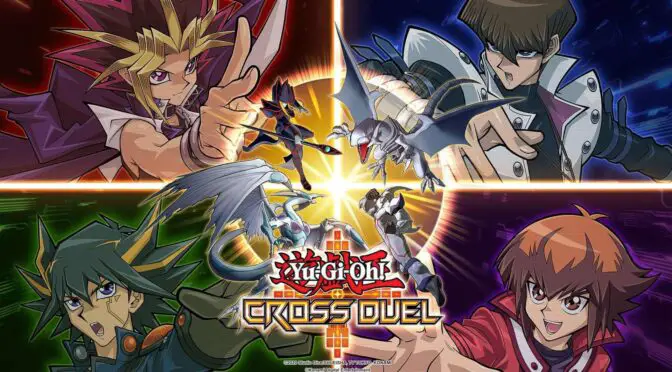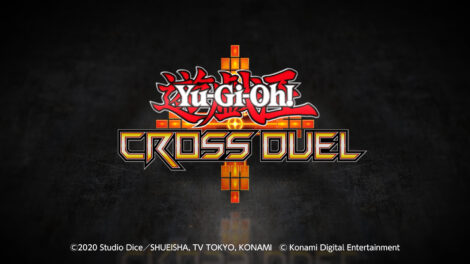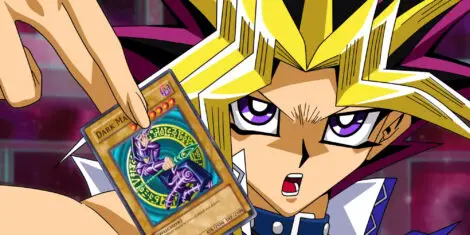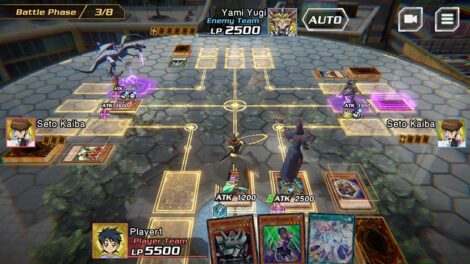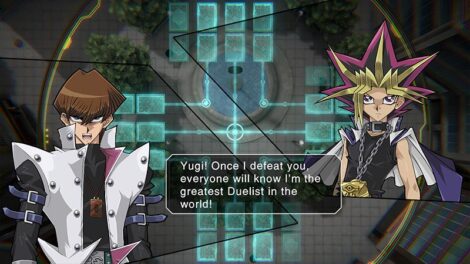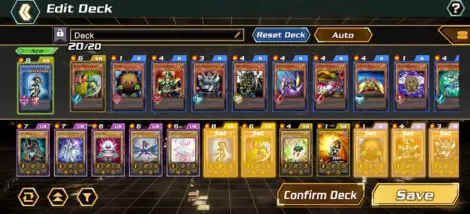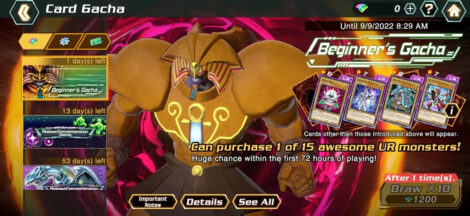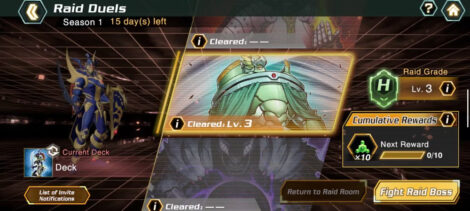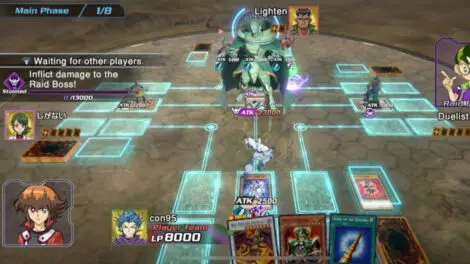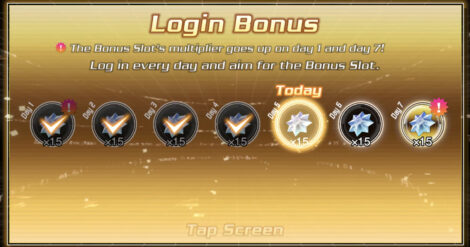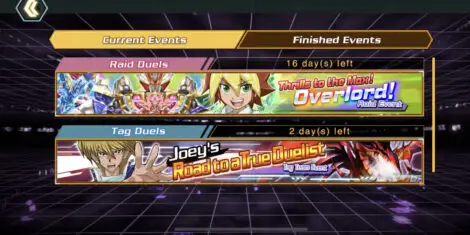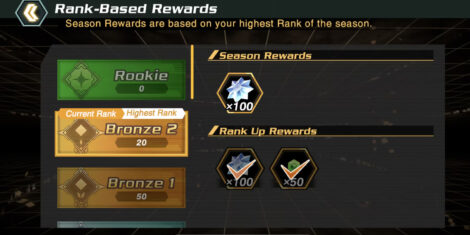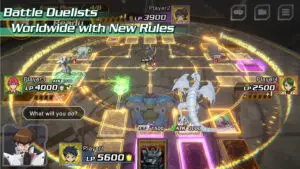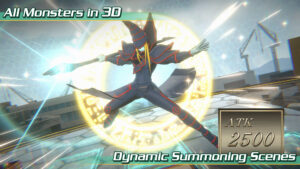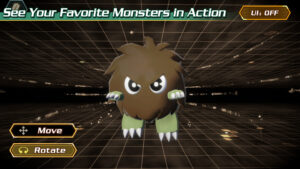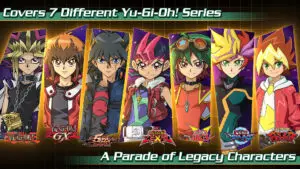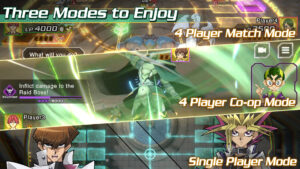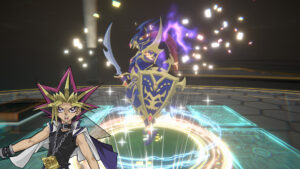Yu-Gi-Oh! CROSS DUEL – Tips, Tricks, Guides
- Genre: Strategy
- Origin: Japan
- Number of Players: 1-4
- System Support: iOS, Android
Manufacturer: Konami
Developer:
Release Date: July 5, 2022 (Android)
US: Sept 6, 2022
UK: Sept 6, 2022
Media: Digital
ESRB Rating: T Teen(In app purchases, Fantasy Violence, Mild Blood, Suggestive Themes)
Yu-Gi-Oh! CROSS DUEL changes the game with dramatic four-player Dueling action.
Tips, Tricks, & Guides Menu:
- The New Cross Duel Rules
- Selecting your Starter UR
- Game Modes
- Beginner Tips
- Tag Duels Guide
- Pro Tips
- Deckbuilding Guide
- Raid Duels Guide
- How to Farm Gems
The New Rules
Don’t expect Cross Duel to play similarly to a traditional Yu-Gi-Oh! game, and be prepared for some changes from the official TCG rules to reflect the new mechanics in this title; it plays similar to a MOBA where you protect your LP (your tower) by sending out monsters to attack or defend lanes. You’re restricted to how you use Spell cards and Trap cards, but you’ll have the freedom to set skills on your monsters, which are like active traits that boost your stats to help gain an additional edge during a match. Below we’ve summarized the new rule set.
Cross Duel General Mechanics
- If Yu-Gi-Oh! were a MOBA, this would be the closest game to the genre. Your monsters are now restricted in lanes and automatically move along that lane (like auto-chess).
- You can’t directly inflict damage on LP on the same turn; it requires two turns to reach the opponent’s LP, provided your opponent doesn’t have any monsters left on the field.
- A duel ends when one player or more has 0 LP.
- Spell cards cannot be set or used in the main phase; they all activate the same way (e.g., no spell speeds to worry about). You can use more than one Spell card at a time in your hand (one after another).
- Trap cards are set during the main phase and are automatically activated during the battle phase; you can set a max of 3 Trap cards in your Trap zones. You can’t change the activation timing of the Trap cards; they occur automatically.
- You’ll always start with one Ace monster in your hand, which are strong monsters with conditions that need to be met for summoning. An example is the Blue-Eyes White Dragon card, where you sacrifice two monsters to summon.
- Duels also end once the turn limit has been reached.
- Bonus cards are powerful Spell/Trap cards used to gain an advantage; you must use your monster to claim the Bonus card (out on the field).
- LP placement is decided at the end of the match; the higher placement, the more rewards you’ll earn.
Restrictions on cards and skills
- You can set skills to monsters to make them stronger.
- No duplicate cards are allowed. All 20 cards must be different.
- Limited slots to how many skills you can equip onto your monsters; these depend on the mode you’re playing. For ranked, you can only have 3 per Ace monster and 1 per regular.
Selecting your starter UR (your Ace monster)
It’s vital to pick the best starter UR that you plan to build your deck around. Below we have the list of which UR cards are in the selection pool:
- Bloom Diva the Melodious Choir
- Blue-Eyes White Dragon
- Dark Magician
- Elemental Hero News
- Firewall Dragon
- Multistrike Dragon Dragias
- Number 17: Leviathan Dragon
- Number 39: Utopia
- Odd-Eyes Pendulum Dragon
- Ojama King
- Red Dragon Archfiend
- Sevens Road Magician
- Stardust Dragon
- Trickstar Holly Angel
Don’t forget that acquiring new cards requires spending on the gacha, so you’ll need to be careful which starting UR you select; this determines your starting deck. We strongly recommend selecting Blue-Eyes White Dragon as your first UR since it is the easiest to summon, offers well-rounded stats, and is simple to build around.
Game modes
Ranked and casual matches will become your bread and butter after you’ve created and upgraded your deck. Still, the campaign and PvE modes are essential to play to comfortably grasp the new rules and collect all the free-to-play Gems that you’ll eventually pour into this game’s gacha system.
Event Matches: Where you’ll play limited-timed content.
Raid Duels: A PvE mode where you team up with three other players (shared LP) to take down a raid boss.
Ranked Matches: Playing Ranked gives you Rank Points (boost your points using Rank Match Tickets), which determines your rank placement. You can go up and down, and you’ll earn season rewards by ranking up during the season.
Room Matches: Host and search for private and public rooms. Your primary hub to duel with your friends.
Tag Duels: The single-player (2v2) campaign where you’ll encounter characters from the Yu-Gi-Oh! series. You partner with an AI to take down your opponents.
Tips and tricks for Beginners
-
- Use your Guaranteed UR Ticket Gacha before it expires (if applicable). You can acquire up to three.
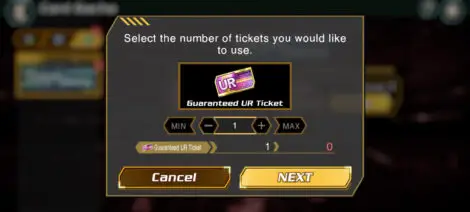
- Collect more cards using Crystals (paid currency) and Gems in the Card Gacha; Gems are obtained from missions and game modes. You can also acquire new cards by trading duplicates.
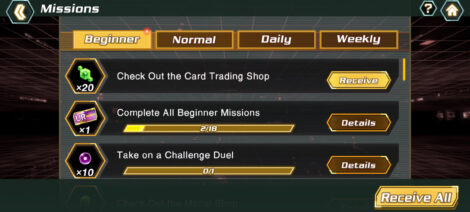
- Reroll your account (delete your game data) if you’re unhappy with the results from the Card Gacha; it is a tedious process, but you can skip the tutorials.
- Upgrade your Ace monster first using the skill system; aim towards unlocking your Ace monster’s master skill. Your skills set you apart from your opponents during matches.
- Use your Guaranteed UR Ticket Gacha before it expires (if applicable). You can acquire up to three.
- Play through the PvE modes first to acquire Gems, build out your deck and upgrade/craft your skills; you don’t want to set foot into ranked until you’re happy with your cards in your deck and have the best skills equipped on your Ace monster. But this step requires time.
- Attack the raid boss’s weak point to deal more damage; you have a limited number of turns to act, so make use of the most potent attacks when available.
- Destroy objects to stun the raid boss; you can summon monsters with a lower attack value (even at zero) to take out the objects.
Section AUTHOR: Faith Leroux via https://www.androidpolice.com/
Yu-Gi-Oh! Cross Duel: Tag Duels Guide
If you’re not comfortable diving straight into competitive Ranked Duels, then the game has you covered with its more accessible Tag Duel mode. This is a single-player experience that allows you to fight against your favourite (or least favourite) characters from each anime series – and here, we’ll tell you everything you need to know about it.
What Are Tag Duels?
Tag Duels are set apart by their two-versus-two gameplay. Before each duel, you’ll pick a partner to fight alongside you against the opposing team. Contrary to other game modes, Tag Duel is the game’s single-player offering, meaning that your partner will not be a human player, but instead a prominent character from the Yu-Gi-Oh! TV shows.
Your deck should follow the standard deckbuilding rules for Cross Duels – in particular, it needs an Ace monster and should contain exactly 20 cards. Aside from this, the world is your oyster – experiment with what works and what doesn’t for the various matchups you’ll come up against.
NOTE: You can choose both your partner and your opponents from every iteration of the Yu-Gi-Oh! anime, from the original Yu-Gi-Oh! all the way up to Yu-Gi-Oh! Sevens.
Essential Information For Tag Duels
In almost every way, Tag Duels are very similar to regular Cross Duels: they follow the same Main Phase to Battle Phase turn order, they span a total of eight turns, and they utilise the cross-shaped battlefield mechanics that give Cross Duel its name.
However, Tag Duels differ from the norm in a couple of important ways:
- You and your tag partner form a team, and each team shares a lifepoint (LP) total that starts at 8,000LP. When one member of a team would lose or gain LP, that change is instead applied to their team. This means that a match either ends at the end of the eighth turn or when a team’s LP total reaches zero.
- When one of your monsters attacks a teammate directly, no damage calculation occurs. Instead, your monster is sent to the Graveyard and your team gains 500LP, regardless of the original stats of the monster sent. This same mechanic features in Raid Duels.
- Your partner’s monsters are not treated as the opponent’s monsters and are thus immune to effects that affect your opponent’s monsters specifically. This also means that your partner will not trigger defensive trap cards that you place on the field for your opponents.
TIP: Although the partnership mechanic in Tag Duels resembles Raid Duels closely, Tag Duels are in fact much closer to regular duels in terms of gameplay. So, whilst your Raid Duel deck might not be very effective here, your regular deck should be able to achieve success.
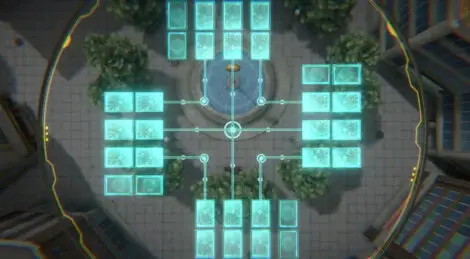
Unfortunately, unlike Ranked Duels, you can only complete a set number of Tag Duels in a given timeframe, since each one consumes one energy. This energy is not obtainable through regular gameplay and the only way to attain more is by relying on the fact that energy regenerates over time.
You can hold a maximum of three energy, and it takes around 45 minutes for a single one to regenerate, so avid players may find their energy running out quickly.
There is, however, one way of regenerating your energy: by purchasing Energy Recovery Items from the Medals Shop. These are cheap, at three medals apiece, although medals are difficult to get ahold of and so these shouldn’t be bought lightly.
Completing Tag Duels earns you Tag Points, which are essentially XP points for Tag Duels, and earn you occasional rewards such as Skill materials and character pieces. In addition, each pair of opponents you can face can be fought at three different levels, and you receive gem rewards for completing each level for the first time.
NOTE: By collecting a total of 20 Tag Points, you can unlock Auto-Play mode, which allows you to complete single-player duels without any player input. This is a great way of AFK-ing duels to, for example, farm Skill materials.
Tag Duelling Tips
- Although your tag partner will bring a powerful deck to the table based on their anime strategies, you can also assign any deck you’ve constructed to them, allowing you to come up with the ultimate Tag Dueling strategy.
- It’s a good idea to swap around your partner every so often, since this way you can gain Trust with a variety of different partners and reap more rewards.
- Similarly, make sure that you fight opponents at each possible level to attain all the First Victory Rewards you can.
- Since monsters sent to your partner will earn your team 500LP regardless of their actual stats, it’s a good idea to send weaker monsters to your partner to get as much out of them as possible. Kuriboh’s 300 ATK might not do that much for you on the battlefield, but for healing your partner it’s just as effective as the all-powerful Blue-Eyes White Dragon.
FREDDIE PAYNE via https://www.thegamer.com/
Pro Tips:
Here are some pro tips you need to get started with Yu-Gi-Oh! Cross Duel.
Use Your Free Gems Wisely
It’s crucial to use your free gems wisely when playing Cross Duel. There is no secondary market for Cross Duel. The only way to get new decks is using gems, and they are related to gacha systems.
Do not use your free gems on just any deck that feels good. Research the meta and choose a powerful deck that fits well with your playstyle. Unlike with the TCG, the lack of a secondary market means that the only way to get a new deck is to pull from the boxes, and once your free gems dry up, you won’t get many more.
So, make sure you’ve chosen a deck that will allow you to be competitive while still having fun.
Don’t Be Afraid To Battle Other Monsters Head On
Make sure you battle your opponents’ monsters as often as possible. TCG players will know that in the TCG, when a monster battles and loses, its controller takes damage, and the monsters don’t lose any stats from the battle.
However, in Cross Duel, players no longer take damage from monster battles, only direct attacks. Monsters also lose Attack Points or Defense Points when they battle other monsters, equal to the attacking Monster’s Attack Points. So if you battle a 3000 ATK Monster with a 500 ATK monster, the 500 ATK monster dies and the 3000 ATK monster becomes a 2500 ATK monster.
This system is new for Yu-Gi-Oh! and isn’t standard by any means. So players who have played other Yu-Gi-Oh! formats may find that they’re tripped up by it.
Unlike in other formats, you don’t have to be afraid to take your Battle Phase. There’s a lot less strategy involved in the Battle Phase in this format. You’ll want to battle as often as possible without clearing your field doing so.
Remember That There’s Only One Main Phase
This one is more for the veteran Yu-Gi-Oh! players than the new recruits, but remember that Cross Duel only has one Main Phase. Veteran TCG players are often used to playing spells, traps, and monsters in both the First and Second Main Phases. In fact, many TCG decks have specific strategies that utilize both Main Phases to build combos.
However, Cross Duel has only one Main Phase. So ensure that you’ve finished everything you want to do before entering the next phase. As you won’t get a second Main Phase like you normally would in the TCG.
Remember The Unique Spell And Trap Card Rules
Spells and Traps work a little differently in Cross Duel compared to the TCG. When using a spell in Cross Duel, you have to play it from your hand on your turn. Unlike in other Yu-Gi-Oh! formats, you can’t set Spell Cards to play later, or on your opponents’ turns.
Trap Card rules remain largely the same. Trap Cards must be set on your turn and cannot be played on the turn they are set. However, Trap Cards can be played on any of the players’ turns and the card must only be set for one of any players’ turns before it can be played. So if you set a trap card on your turn, you can play it starting on the next player’s turn.
This is one rule change that is liable to trip up a lot of veteran players who are used to setting Quickplay Spells and using the TCG Spell Speed rules.
Special Summon Often
Special Summoning is a type of summon that encompasses many sub-types such as Synchro and Fusion summoning. This type of summon is exceptionally important in Yu-Gi-Oh! because it doesn’t count towards your summon-per-turn limit.
While playing a monster from the hand to the field uses one of your three summons, Special Summons don’t. So, utilizing Special Summons can help you bring your deck into full stride faster and help you defeat your opponents.
Additionally, many decks rely heavily on Special Summoning. Red Dragon Archfiend decks are centered strongly around Synchro Summoning large monsters. So you can target your opponent’s critical monsters to prevent them from Synchro summoning. Furthermore, you may consider picking a deck that is largely based on Special Summoning. Since Cross Duel allows for three normal summons per turn, up from the one allowed in the TCG, you’ll have exceptionally easy access to Synchro and Fusion summoned monsters that you can use to defeat your opponents easily.
However, if your special summoned monsters are Synchro, Fusion, XYZ, or Link Monsters, remember that you won’t be able to summon them unless you draw them, unlike in the TCG.
Determine A Threat List
Determining a threat list is one of the easiest ways to secure victory. During the first turn, note which cards your opponents have summoned and played. These cards typically give you a hint as to what cards they intend to play in the coming turns.
For instance, if your opponent summons several Blue-Eyes monsters, there’s a high likelihood that they’re playing a Blue-Eyes deck. This means you’ll need to watch out for cards that allow for faster summoning of larger Blue-Eyes monsters, like Blue-Eyes White Dragon, that you’ll have to contend with.
Knowing what your opponent’s cards do can help you determine what order you need to kill their monsters in and what their win conditions are. For instance, Red Dragon Archfiend decks require a lot of Tuner monsters to complete their combos. So if you can take out their Tuners, the deck will have a lot more difficulty hitting its stride.
You’ll also need to consider what cards you play in what zones based on your opponents’ moves. Since each monster Zone can only attack one monster, you’ll need to determine which monsters you play to defend against which players.
Deckbuilding Guide:
Here’s everything you need to know to build a strong deck in Yu-Gi-Oh! Cross Duel.
Cross Duel will see you battling in four-player duels on a cross-shaped field, and carefully positioning your monsters along lanes to achieve victory.
An essential part of the experience is deckbuilding. Just as it is in the TCG, you’ll need to build your deck to use in your many battles, which will often evolve as you gain stronger cards and monster skills. It’s a lot to get used to, especially for a completely new way of dueling, but we’ll go over everything you need to know.
Deckbuilding Basics
Don’t let the cards fool you: Cross Duel is an entirely different beast from other Yu-Gi-Oh! games out there. As such, much of what you know about deckbuilding in the TCG isn’t relevant here, so forget (almost) everything you know about putting decks together for other games. Instead, start with a basic deck and build up a more cohesive strategy as you become more familiar with how the game plays and what cards you particularly enjoy seeing in your hand.
That said, there are still a few rules you need to know before you hit the deck editor. In particular:
- You need to choose an Ace monster, who will automatically appear in your starting hand every game.
- Your deck needs to contain exactly 20 cards, including your Ace monster. No more, no less!
- Every card in your deck needs to be different – you can only have one copy of each.
You should pay particular attention to which Ace monster you pick since this will shape your strategy as a whole. The game heavily leans you toward high-level monsters such as Dark Magician and Black Luster Soldier, and with good reason: Attack and Defence stats matter a lot more in Cross Duel than in the regular TCG, and so guaranteeing a high-stat monster in your starting hand is a fantastic way of turning the tables on your opponents. However, you can choose any monster as your Ace if you have the strategic justification for doing so.
How To Obtain New Cards
Cross Duel gives you two main ways of adding cards to your collection: the Card Gacha and the Shop. Although the Shop guarantees you the specific card you want, you need to exchange other cards to get them, so the main way of widening your collection will be by praying to Slifer and pulling on the Card Gacha.
There are three different types of Card Gacha in the game: there are special Gachas that are purchased with Crystals, regular Gachas that are bought with Gems, and the Ticket Gacha which is where you redeem your tickets. Which currency you have will dictate which Gacha you pull on, but all three work in the same way in that you roll a certain number of times and receive a randomised set of cards available from the Gacha on each roll.
NOTE: Crystals are the game’s premium currency, whereas Gems are a currency earned by completing missions and Ranked duels. Don’t get them confused!
Each pull on the Gem and Crystal Gachas will get you a pack of three cards where one has a chance of being either a Super Rare (SR) or an Ultra Rare (UR). The ticket Gacha, on the other hand, will give you one card per ticket, but it will be of a guaranteed rarity – so, for example, using a UR Ticket will guarantee you a UR card.
The Shop works similarly to crafting systems in other games: you can pick any card you wish, but you’ll need to trade four cards of the same rarity as that card to receive it. Additionally, you can only trade cards from your Vault, which is where all of your duplicate cards from Gacha pulls get sent automatically.
WARNING: You might think that cards from your Vault don’t matter, since you can only have one copy of each card in your deck, but this is not the case. Duplicate copies of a card can be used to unlock more Skill slots for that card, meaning that you should hold on to duplicates of your favourites to make them even more powerful.
Tips For Building Your Deck
The most important thing you should remember about deckbuilding in Cross Duel is to always be open to new ideas. During your matches, keep an eye out for interesting strategies you come across and think about how you might replicate them in your deck. Experimentation is also key, since it is the only way you will learn what works and what doesn’t, and more importantly what fits your playstyle.
That said, there are a few other things that you should bear in mind to squeeze the most out of your deck:
- Pick your Ace monster carefully – it is the linchpin of your strategy. While your favourite high-level monster is an admirable choice, don’t count out the little guys either, since with the right tactics they could prove to be valuable cards to guarantee in your starting hand. For example, picking an Ace monster with the Superspeed ability means that you can place it in the centre lane on your first turn every game, essentially guaranteeing you first dibs on the valuable prize card in the middle of the battlefield.
- Make sure you don’t forget to kit out all of your monsters with Skills – not just your Ace. The more easily-attainable Skills such as ATK Boost can in themselves provide important strength boosts for your deck, but some of the more unique Skills can turn weaklings into game-saving heroes. You might not be scared of Winged Kuriboh now, but if it has the Curse Skill equipped then it can take your Ace monster out of action for a long time.
- Optimise the number of Monsters, Spells, and Traps in your deck as effectively as you can. Since monsters act as your main form of defence and your only form of offence, these should take up most of your deck; at least 12-15 of your cards should be monsters. Spells and Traps, on the other hand, are not that different from one another – both act as surprise mechanics in the Battle Phase – and so which you decide to pick here will be down to your personal preference.
- Double-check that your deck makes sense before you unleash it into the world. If you’re playing Elemental HERO Flame Wingman with his unique Skill, do you also have enough Warrior-type monsters to consistently be able to summon him? Is there any point having Scrum Force in your deck if you’re only playing a handful of low-level monsters? Considerations such as these will help you to make your deck feel more cohesive and will aim it towards a sharp strategy.
Finally, you should change your deck based on what you’re doing. Having separate decks for Raid Duels and Ranked Duels is an excellent idea since the two modes work on very different mechanics. Additionally, your Raid Duel-only monster Skills aren’t going to help you in Ranked, and neither are cards like Butterfly Dagger – Elma which impart Raid Duel effects.
Raid Duels Guide
Cross Duel also features a cooperative mode: Raid Duels. Here, you’ll be teaming up with duelists across the world to take down powerful Raid Bosses, who have incredibly high stats and many special abilities at their disposal.
Raid Duel is a four-player cooperative mode for Yu-Gi-Oh! Cross Duel. You’ll be teaming up with your fellow players to take down a Raid Boss: a large, powerful monster in the centre of the map. Raid monsters have no defence stat, but instead have massive attack stats that will dwarf anything you put up against them.
Combat with Raid Bosses happens in the usual way: your monster battles with the Raid Boss, the monster with the least attack is destroyed, and the monster with the higher attack stat loses attack equal to the other monster’s. A Raid is completed when the Raid Boss is destroyed by having its attack dropped to zero, hence you will be continually sending in monsters to lower the Raid Boss’ attack until you can eventually overpower it.
Conversely, Raid Duels are lost when either the team’s life points hit zero or the turn limit is reached. The number of turns you have to defeat the Raid Boss will vary between duels, so make sure you always know how many turns are left in the duel!
Each turn in Raid Duels is split into three phases. The first phase is the boss phase – unique to Raid Duels – whereas the others are the main and battle phases from standard Cross Duels. In the boss phase, the Raid Boss gets to act, performing a selection of actions that could vary from changing which direction it’s facing to summoning minions to aid its cause.
Key Information
The first thing you will notice about Raid Duels is that the Raid Boss always faces a certain direction. This means that Raid Bosses usually have an exposed weakness from at least one attack angle – usually on their back. Attacks dealt to these weak points will deal double damage, so if you have a weak point facing you, you should take full advantage and launch some of your most powerful monsters into the fray.
TIP: You can also occasionally stun Raid Bosses during the match by fulfilling certain conditions; these could vary from clearing objects to dealing a certain amount of damage. When it’s stunned, every side of the Boss becomes a weak point, making this the perfect opportunity to go all in!
The Raid Boss has a number of tricks up its sleeve to fight back, however – here are all the actions that Raid Bosses can perform in the boss phase:
- Change of Direction: the Raid Boss will rotate to face a different direction.
- Effect Activation: the Raid Boss activates a unique effect. This will vary between Raid Bosses.
- Boss Attacks: the Raid Boss attacks the player in front of it directly, dealing damage based on the Boss, its level, and the state of play.
- Object Appearances: the Raid Boss will make objects appear on the battlefield.
- Raid Monster Summons: the Raid Boss summons some monsters to fight against the players.
- Spell/Trap Card Activation: the Raid Boss will tell players which Spell/Trap cards they are planning to activate in the coming battle phase.
You will need to work with your team to play around these moves and overpower the Raid Boss.
In particular, the objects that Raid Bosses occasionally spawn will have various effects, such as augmenting the Boss’ abilities. These can appear on any path on the battlefield and can be taken down by sending monsters to attack them. They don’t have attack stats, only a hit points value that will decrease by one for each monster that attacks it. Thus, clearing obstacles from the field is all about how many monsters you send in rather than how powerful those monsters are.
TIP: Clearing obstacles is a great way of getting mileage out of your weaker monsters, since they will be just as effective as the most powerful attackers. Moreover, since many low-level monsters have access to the Anti-Object ability, which increases the damage they do to objects by one, they could be even better than the big hitters!
When you choose a Raid Boss to face in battle, you will also need to decide what level you want that Boss to be at. Each Raid Boss can be between levels one to three, and as you might expect, Bosses at higher levels have more attack points and are harder to defeat. However, they also give out increased rewards, so if you’re up to the challenge, then it’s worth taking them on.
Author: Freddie Payne
How to Farm Gems
Yu-Gi-Oh! Cross Duel has many modes that help players earn gems, the currency that pays for new cards, and we present the fastest ways to earn them:
What are Gems?
In Yu-Gi-Oh! Cross Duel, gems are the white, eight-pointed items players get from logging in, completing missions, and meeting certain milestones in the game’s many modes. They act as a sort of premium currency in the game alongside the rainbow diamond-cut Crystals (which can only be obtained through purchases.)
Both of them allow players to pull in the Card Gacha for at least 3 to 30 cards depending on the number of draws fans do at a time. Where the Crystal gacha allows players to get guaranteed URs, the gem gacha isn’t so kind. That’s why many Cross Duel players, especially the free-to-play ones, may want to aim for as many gems as fast as possible.
Yu-Gi-Oh! Cross Duel’s Log-In Bonuses
At the start and end of each week, Cross Duel’s log-in bonus chooses a multiplier from set intervals such as x5, x10, and x25. For the first day, this marks how many gems players will obtain from the log-in bonus each week.
For example, if a player lands on the x15 multiplier on the first day, they’ll be given 15 gems until the “bonus slot” on the seventh day activates. The multiplier will roll again, but this time, it’ll use the number of gems gained daily as the base amount. This means that as long as players log in each day, they can walk away with hundreds of gems by the end of the week.
Players should do their best to log in each day to earn as many gems as they can to eventually build their favorite Yu-Gi-Oh! decks.
Missions and Events in Yu-Gi-Oh! Cross Duel
Alongside the log-in bonus, Yu-Gi-Oh! Cross Duel also offers missions players can clear daily and weekly for rewards such as more gems, skill material, medals, and more. However, whenever there are events being held in Cross Duel, even more missions will be available.
Fans should play the events to clear the missions, as events have their own cumulative rewards fans can earn. Players should keep their eyes out for Raid Events, as the cumulative rewards give players gems every four gifts, and the mission goals should be easy to clear with the help of three other players working together to beat the raid boss.
Raid Events offer the most gems out of the events available in the game so far, as seen with the event starring Yuga Ohdo from Yu-Gi-Oh! Sevens.
The Best Mode to Grind for Gems in Yu-Gi-Oh! Cross Duel
Between the Tag Duel, Raid Duel, and Ranked Matches modes that Cross Duel offers, Ranked Matches offer the most gems for players. Even though playing against other duelists may intimidate some fans, even if they come in last place, players can walk away with gems as a reward through the Battle Rewards that get added up at the end. Bronze rewards earn 2 gems, silver earns 7, and gold earns 20.
These rewards stack and don’t run out, with plenty of gems also available through ranking up in the season as well as through cumulative goals. Playing Ranked is certainly worth players’ time in the end, even if they’re missing some iconic Yu-Gi-Oh! monsters.
The table below indicates how many gems you can pick up for each.
| Rank | Rank up bonus | Season rewards | Points needed for rank up |
| Rookie | – | – | 0 |
| Bronze two | 100 gems | 100 gems | 20 |
| Bronze one | 100 gems | 150 gems | 50 |
| Silver two | – | 200 gems | 90 |
| Silver one | 100 gems | 250 gems | 150 |
| Gold three | 100 gems | 300 gems | 220 |
| Gold two | 100 gems | 350 gems | 300 |
| Gold one | 100 gems | 400 gems | 380 |
Gems can be earned across every mode in Cross Duel, but some offer more than others. Considering the importance of duplicate cards in regard to unlocking Cross Duel’s unique skills, even the most unexciting Card Gacha pulls can be rewarding. As a result, farming gems is crucial to making sure fans gather the cards they need quickly.
Screenshots and images
More info and images coming soon..
ⓒ Studio Dice / Shueisha TV Tokyo KONAMI
© Konami Digital Entertainment
We will update as soon as we learn more.
Go to:
[sb_sibling_prev] | [sb_sibling_next]
[sb_parent]
[sb_grandparent]

